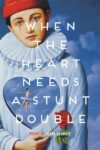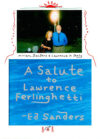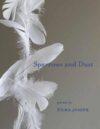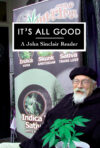Mohawk: John Sinclair (signed)
“The whole piece is a low-down plucked upright bass, brushes and breaks deal with Sinclair’s one hundred thousand joints-later-voice sounding like a stoned, jazz obsessed grizzly bear reeling off listing, lilting lines like on the title track “June 6th 1950 Bird and Dizz and Monk and Curly Russell on bass”. He’s actually trying to describe how jazz happened, how it became and how it is – and to transport the listener into that world.
It’s a considerable attraction, for sure, as you begin to feel privy to some backroom New York jam session in the early ‘40s seared through with sudden bursts of scratch-record modernity. It’s a thrilling clash as we hear Sinclair describe these artists “creating a new nation of music”.
“Straight No Chaser” named for the Thelonius Monk classic, sees Sinclair recounting a conversation between Art Blakey and Monk over chimes, shimmering cymbals, alternately furious and absolutely zen drumlins, reversing glitches and rumbles filling the space where horns might usually be found, a glockenspiel batting its head against the waves of strange sound.
The pace really picks up on tracks like the racing “Bloomdido” set “In Harlem, in the early days of the new music” – you are right there with him when “The music hit hard and deep / Monk and Bird and Dizzy”. This is jazz during wartime, skittering and panicked as Sinclair declares “They brought music to life / They brought life to music”.
There are plenty more lines worth noting here – “They gave it life and made it bloom / Great flowers emerged in the middle of the night” he cries, filled up with music and wonder.
Elsewhere the formula of basic, stripped down acoustic band (bass, acoustic, drums) augmented with jarring samples and loops, all serving as a spinning platform for Sinclair’s lyrical, heart-full poetry works just as effectively;
On “Eronel”, which borrows liberally from Monk’s original of the same name, we get an exploration of reversals, mirrored sounds and words, “A twisted glimpse into the mind of Monk at work”. A saxophone is spliced, warped and split over thundering drums.
Where Sinclair’s obsession (and an obsession it must be – this project is the culmination of the seed of an idea that was sewn in 1982) with his subject really shines is on the immensely personal “My Melancholy Baby” (you’re sensing the theme with these titles now?) which recounts “in the awful aftermath of Hurricane Katrina” filmmaker and friend Stevenson Kalfi (Piano Players Rarely Ever Play Together)’s struggles to continue his art without funding or even much attention. Kalfi is, we’re told, “this beautiful cat with a big heart and huge imagination” and we get namechecks for the likes of ‘Tuts’ Washington and legendary banjoist Emanuel Sayles. It’s rich, enthused stuff.
Same goes for “An Oscar for Treadwell” where George Treadwell is given similarly eulogious treatment. Here we’re again with “Monk and Bird and Dizzy” “In New York City at the end of the 1930s”. it’s a music-poem of all night jams “in midtown from 9pm to 3am” and on til dawn. You can taste the reefer smoke, feel the tired eyes of the tweleve hour a day players in “the jazz centre of the world”, “cutting a new edge on the shape of the music / Pointing into the future”. Suddenly we’re at a house party with Coleman Hawkins, Roy Eldridge, Lester Young, Billy Holliday, Jack Kerouac and endless, nameless sailors, pimps, drug dealers…”This is the shit!” the man from Flint, Michigan hardly has to mention.
The words here are like a shorthand version of Gene Lees’ excellent book of personal jazz histories “Meet Me At Jim and Andy’s” – both idealise jazz and its players, both celebrate the scenes and sounds of the respective styles and times they lived through.
Such are Sinclair’s lyrical fireworks you could be forgiven for overlooking the feel, the accuracy, the joy of the playing here – orchestrated by Brit Steve Fry –suffice to say, every element of the backing reflects the generosity of spirit, heart and sincerity that Sinclair speaks with.
Things are perhaps more playful on “Leap Frog”, an insistent jam with yes, jazz flute and horn samples and, of course, “Bird and Monk and Dizzy before the second world war” – yet musically it’s a close cousin to something Geoff Barrow’s Beak> might come up with.
Apocalyptic but slight closer “Carolina Moon” ends the session with grace and power – but don’t stop listening there. Especially if you’re a Beatles fan. Seriously.
Mohawk is an album that feels great, imparts wisdom, drops sweet details and encourages both fandom and participation. If there’s fault to be found it’s in the record’s brevity – it’s a short album to put together when drawing on Sinclair’s lengthy body of work, some of the tracks no more than a few choice lines, Regardless, it’s a ray of warming jazz sunshine that hopefully will encourage some exploration of the form among those who know this stoner poet only for his notoriety in the MC5 days. Yes, it’s hard to like a hippie, but, on this evidence, here’s one you could really love.” –review from The Line of Best Fit
As new CD, unplayed, signed by John Sinclair on front cover.
$ 45.00
Out of stock





